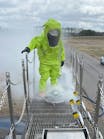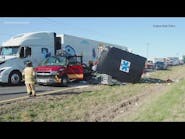The majority of orthopedic injuries to EMTs, firefighters and paramedics are in the lower thoracic spine and lumbar spine. The twists and turns of removing a patient from a vehicle crash and not maintaining proper body mechanics when sliding a patient across a bed to the gurney place a responder’s back at risk. Furthermore, a 2010 American Journal of Epidemiology study found that the risk of lower back pain was related directly to increases in body mass index (BMI), with those who were considered obese at the highest risk. (People are considered overweight when their BMI calculates to 25 percent–30 percent and obese when it’s more than 30 percent.) If you are overweight, the risk of serious back injury goes up 15 percent, and if you are obese, the risk increases by 48 percent.
There is a lot to be said about prevention of back injuries for first responders. Certainly, the advent of power loading systems has had a tremendous effect on reducing back injuries. In a study that compared two large ambulance services (one that implemented power loading systems and one that didn’t), back injuries were reduced by 78 percent among the staff of the service that had the power loading systems.
In my own agency, three serious back injuries over a two-year period affected not only operations but the staffing budget and workers compensation rates. The following year, a state EMS grant allowed us to put power loading systems in each ambulance. Our agency hasn’t had a patient-related back injury since then.
Although some agencies would get beat up over EMTs and firefighters doing yoga or Pilates on duty, the benefits of stretching and core-strength-building are as important as cardio and strength training.
In discussing the weight and back injury connection, we also must talk about sleep. Sleep deprivation is a leading cause of weight gain. David Peterson’s work on sleep deprivation [firehouse.com/12268164] in first responders should be mandatory reading for every EMT, firefighter and paramedic.
The lower extremities
In its 2016 report, “Patterns of Firefighter Fireground Injuries,” the NFPA noted that knee injuries represent about 10 percent of firefighter injuries; ankle injuries account for 6 percent of lower extremity injuries.
Protecting a knee involves: creating an environment of nonslip surfaces and clean areas, including for steps into and out of vehicles; strengthening the muscle groups that are around the knee; and potentially utilizing protective equipment, including braces and pads. In a ride along with Quito Fire in Ecuador, en route to a motorcycle crash in the old part of the city, the paramedic donned industrial-grade knee pads. He did this knowing that he might need to assess a patient and initiate care on the brick and cobblestone streets in that area. The knee pads could protect against a soft tissue injury on a knee.
Boots that have ankle support and a substantial sole help to cushion the impact of getting in and out of an ambulance. The shock of those actions all the way up the leg to the hip and spine is well-documented. Poorly constructed or worn out soles can lead to pronation or rolling an ankle. Inspection of boots and soles might be as important as the monthly inspection on turnouts.
Preliminary reports and insurance actuaries point to the significant increase in shoulder injuries among EMS workers, including tears in the rotator cuff and the labrum. Although an in-depth study hasn’t looked at this in EMS, I hear of a lot of EMS workers out because of these injuries. Of course, the patient population, the gurney, and, often, the contents of our bags and equipment aren’t getting any lighter. The static grip that’s needed to support the gurney while the wheels go up or down place stress on a shoulder (or elbow or wrist). Not standing in alignment and preventing a shoulder from leaning forward at a 30-degree forward angle from the hips put stress on the shoulder, too. A preventive regime should look to strengthen the muscles that support that joint as well as to reduce abdominal size that forces that awkward angle on the shoulder.
Because NFPA 1582: Standard on Comprehensive Occupational Medical Program for Fire Departments has exclusion criteria for several orthopedic injuries—and with the large cost and effect on families—greater effort to assess joints and to work on overall fitness is needed. Fortunately, the National Institute for Occupational Safety and Health is finishing a three-year study that’s titled “Pilot Testing the Use of State EMS Response Data for Occupational Health Surveillance of EMS Workers.”

Bruce Evans | Fire Chief
Bruce Evans, CFOD, SEMSO, NRP, MPA, is the fire chief for the Upper Pine River Fire Protection District, which is located outside of Durango, CO. He retired as an assistant chief from the North Las Vegas Fire Department after serving 27 years in Southern Nevada’s Fire and EMS system. Evans has been a course developer for many of the National Fire Academy curriculums and serves as a technical writer. He is the recipient of the prestigious 2010 James O. Page EMS Achievement Award and was awarded the NAEMT Presidential Leadership Award in 2014. The Colorado Governor appointed Evans to the State Emergency Medical and Trauma Advisory Committee in 2014. He is NAEMT’s liaison to the National Academies of Medicine preparedness committee and coauthored texts on EMS management and crew resource management and wrote a text on EMS quality improvement.






